Pacific Railroad Unites Nation, Fosters Growth
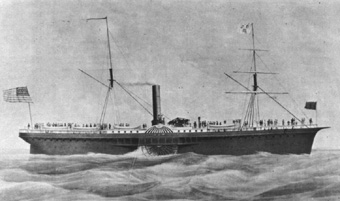 As early as 1832 people were dreaming of a railroad to the Pacific Coast as perhaps first expressed in the Emigrant, an Ann Arbor, Michigan newspaper. In 1836, John Plumbe, a civil engineer in Dubuque, Iowa, called a public meeting to discuss the concept, the first of many such meetings to be called throughout the nation.
As early as 1832 people were dreaming of a railroad to the Pacific Coast as perhaps first expressed in the Emigrant, an Ann Arbor, Michigan newspaper. In 1836, John Plumbe, a civil engineer in Dubuque, Iowa, called a public meeting to discuss the concept, the first of many such meetings to be called throughout the nation.
Much of the early debates was not so much over whether it would be built, but whether it should follow a central route or a southern route. The prominent champion of the central route railroad at this time was Asa Whitney who envisioned a route from Chicago and the Great Lakes to northern California, paid for by the sale of land to settlers along the route. In June 1845 Whitney led a team along the route to assess its capabilities.
California became part of the United States with signing of the Treaty of Guadalupe Hidalgo on February 2, 1848, at the conclusion of the Mexican-American War. The treaty granted the United States the Rio Grande boundary for Texas, along with ownership of California, and a large area comprising New Mexico, Arizona, Nevada, Utah, and parts of Wyoming and Colorado in exchange for paying $15 million to Mexico and claims of American citizens against Mexico.
After the news spread that gold was discovered at Sutter's Mill in Coloma on January 24, 1848, gold fever spread from coast to coast. Men dropped what they were doing to head to the riches of the California gold fields with the California Gold Rush of 1849. California's population grew rapidly. In 1849 a state constitution was written, and a governor and legislature were chosen. California joined the Union as a free state on September 9, 1850, as part of the Compromise of 1850.
Unfortunately, there were limited choices in travel to California. One could travel by steamship around Cape Horn in several months, but the seas could be rough, the journey could be hazardous as well as slow and expensive. This was, however, the most economical route for shipping manufactured goods and machinery to the West Coast.
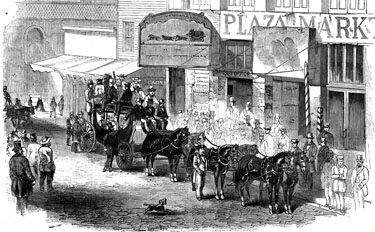 A short cut traveling over land through the Panama swamps could reduce the time by about one month, however many died of cholera and the trail could be dangerous too. Transit across the Isthmus typically took four to five days. William H. Aspinwall operated the Pacific Mail Steamship Company which was awarded a contract in 1848 to transport mail between New York and California via the Panama Isthmus. Letters were supposed to reach California from the East within four weeks, a goal seldom achieved. With his partners, Aspinwall sold stock, and began to construct a railway across the Isthmus in 1850. With its completion in January 1855, the Panama Railway became the world's first transcontinental railroad, stretching 48 miles across the Isthmus of Panama from Colón on the Atlantic Ocean to Panama City on the Pacific Ocean.
A short cut traveling over land through the Panama swamps could reduce the time by about one month, however many died of cholera and the trail could be dangerous too. Transit across the Isthmus typically took four to five days. William H. Aspinwall operated the Pacific Mail Steamship Company which was awarded a contract in 1848 to transport mail between New York and California via the Panama Isthmus. Letters were supposed to reach California from the East within four weeks, a goal seldom achieved. With his partners, Aspinwall sold stock, and began to construct a railway across the Isthmus in 1850. With its completion in January 1855, the Panama Railway became the world's first transcontinental railroad, stretching 48 miles across the Isthmus of Panama from Colón on the Atlantic Ocean to Panama City on the Pacific Ocean.
Travel by stagecoach was also an option, but this was also slow, uncomfortable and dangerous. The Post Office issued a contract to the Overland Mail Company stage line of John Butterfield for semi-weekly overland mail service in September 1858. Letters were supposed to arrive in California within 24 days but often took months.
An man moving west could also purchase a covered wagon to move with his family from the East in several months, but the roads were hot, rough and dangerous, many died along the way. An estimated 250,000 gold-seekers and farmers used the California Trail to reach northern California from the 1840s until the completion of the transcontinental railroad in the late 1860s.
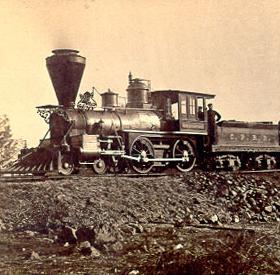 Congress Debates Proposed Railroad to the Pacific
Congress Debates Proposed Railroad to the Pacific
In 1850 the U.S. House of Representatives Committee on Roads and Canals championed the idea of a transcontinental railroad to the Pacific. The railroad, the committee stated, would "cement the commercial, social, and political relations of the East and the West," and would be a "highway over which will pass the commerce of Europe and Asia." Throughout the 1850's numerous railroad conventions were held in major cities in the East and in San Francisco promoting the idea.
The dream of a transcontinental railroad had been evidenced by the opening of the first railroad west of the Mississippi, the Pacific Railroad of Missouri, in 1852. It was five miles long, stretching westward from St. Louis.
In 1853, Congress authorized a survey of the most desirable possible routes for a western railway, five different routes were surveyed. Jefferson Davis, Secretary of War, submitted the report to Congress in February 1855.
The Select Committee on the Pacific Railroad and Telegraph submitted a bill to Congress in August 1856 proposing construction of a Pacific Railroad. Unfortunately, while politicians agreed on the benefits of a Pacific Railroad, lawmakers could not agree on an Eastern terminus because the area where the terminus was placed would gain immense political and economic benefits for the region it was in. The states in the North and South had become deeply divided by sectional views, preventing agreement on a route.
Theodore Judah Promotes Railroad, Surveys Route over Donner Pass
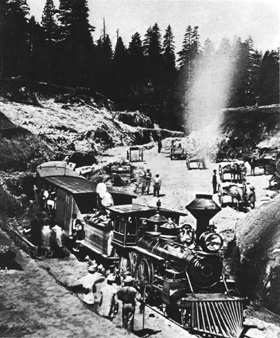 Theodore D. Judah, an engineer for the Sacramento Valley Railroad in California, had become obsessed with the dream of a Pacific Railroad. In 1856 Judah wrote a proposal in support of a Pacific railroad which he distributed in Washington. In September 1859, Judah was chosen to be the accredited lobbyist for the Pacific Railroad Convention. In February 1860 Iowa Representative Samuel Curtis introduced a bill to build the railroad which passed the House but died when it could not be reconciled with the Senate version.
Theodore D. Judah, an engineer for the Sacramento Valley Railroad in California, had become obsessed with the dream of a Pacific Railroad. In 1856 Judah wrote a proposal in support of a Pacific railroad which he distributed in Washington. In September 1859, Judah was chosen to be the accredited lobbyist for the Pacific Railroad Convention. In February 1860 Iowa Representative Samuel Curtis introduced a bill to build the railroad which passed the House but died when it could not be reconciled with the Senate version.
In the summer of 1860, with the help of Daniel Strong a pharmacist from Dutch Flat, Theodore Judah surveyed possible routes through Donner Pass.
Collis Huntington, a hardware merchant, heard Theodore Judah lecture in Sacramento in November 1860, and he invited Judah to his office to hear his proposal in detail. Judah convinced Huntington and three other Sacramento merchants that the road could be built and be profitable. Leland Stanford, Collis P. Huntington, Mark Hopkins, and Charles Crocker incorporated the Central Pacific Railroad Company of California on June 28, 1861.
Judah worked together with eastern promoters, for legislation to aid the Pacific Railroad. President Lincoln found the proposed line to be both beneficial to the military and necessary for binding the Pacific Coast to the Union, and supported the campaign. Unfortunately Judah died in November 1863 before major construction began, after contracting Yellow Fever while traveling over the Isthmus of Panama from New York.
Pacific Railroad Act of 1862 Enables Construction of Line
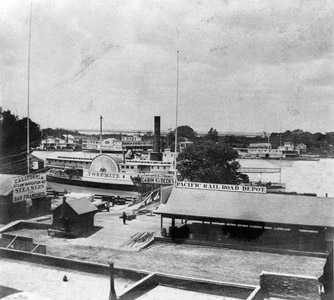 The Pony Express from 1860 to 1861 was to prove that the central route was viable during the winter. The secession of the Southern states removed opposition to a central route. With the American Civil War raging and a secessionist movement in California gaining steam, the need for the railroad became more urgent.
The Pony Express from 1860 to 1861 was to prove that the central route was viable during the winter. The secession of the Southern states removed opposition to a central route. With the American Civil War raging and a secessionist movement in California gaining steam, the need for the railroad became more urgent.
Representative Curtis again introduced a bill in 1861, entitled "AN ACT to aid in the construction of a railroad and telegraph line from the Missouri River to the Pacific Ocean, and to secure to the government the use of the same for postal, military, and other purposes", which finally passed both the House and Senate in June 1862. President Lincoln signed the Pacific Railroad Act of 1862 on July 1, 1862. The act of Congress chartered two railroad corporations to build the line, the Union Pacific to build westward from the Missouri River and the Central Pacific to build eastward from Sacramento, California.
The Pacific Railroad Act of 1862 authorized the issuance of U.S. Government Bonds as loans to the two companies based on miles of track completed. To provide the new companies with the necessary financial incentive, the Act also provided land grants. For each mile of track a company laid, it would receive in addition to the right of way for the track bed itself, twenty square miles of land in alternate sections (laid out in a checkerboard pattern) along the right of way. Portions of the land were later profitably sold to arriving settlers by the railroad companies.
Central Pacific Railroad Begins Construction in Sacramento
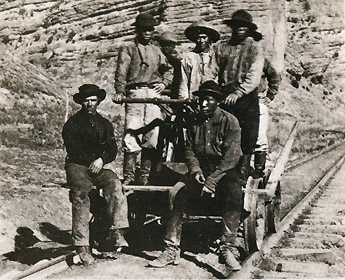 The Central Pacific Railroad broke ground at Front and K Streets in Sacramento on January 8, 1863, the Union Pacific a Omaha on December 2, 1863. Crocker took charge of construction. The Central Pacific laid its first rail on October 26. The Central Pacific's first locomotive, No. 1 Governor Stanford, was placed in service on November 10. Most of the rail, supplies and equipment for the Central Pacific had to be shipped around Cape Horn at the tip of South America. It typically took from three to seven months or longer for shipments to arrive from the East.
The Central Pacific Railroad broke ground at Front and K Streets in Sacramento on January 8, 1863, the Union Pacific a Omaha on December 2, 1863. Crocker took charge of construction. The Central Pacific laid its first rail on October 26. The Central Pacific's first locomotive, No. 1 Governor Stanford, was placed in service on November 10. Most of the rail, supplies and equipment for the Central Pacific had to be shipped around Cape Horn at the tip of South America. It typically took from three to seven months or longer for shipments to arrive from the East.
Progress was slow for both companies during the war years with price of materials high and labor scarce. The Railroad Act of 1864 doubled the resources made available to the railroads by the previous act.
The Central Pacific pushed their rails 18 miles east of Sacramento to Roseville by February 1864 and train service began in April. Track was completed 31 miles to Newcastle and trains began running June 10. Progress slowed as track crews entered the Sierra Nevada foothills. Winter weather and the increasing necessity for tunneling in the mountains began to slow progress further. Railroad service began to Auburn, 36 miles east of Sacramento, on May 13, 1865. The CPRR reached Clipper Gap, 43 miles away, on June 10, 1865, and Colfax, 55 miles away, was reached on September 10, 1865.
The work began with the surveyors who selected the best route. The graders followed behind the surveyors, digging through the hills, blasting tunnels, filling in the valleys and building bridges. 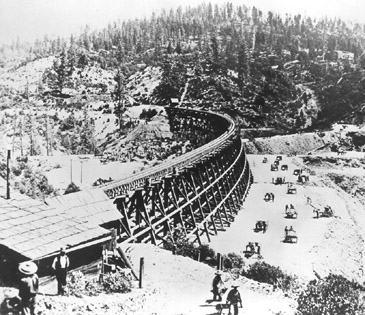 All grading and track laying was done by hand, using picks and shovels, black powder for blasting, and mule carts to hall the debris away. Behind the graders followed the track layers, laying down the hand hewn wooden ties and rails. the rails were measured to make sure they were exactly the right distance apart then spiked into place using specially designed hammers.
All grading and track laying was done by hand, using picks and shovels, black powder for blasting, and mule carts to hall the debris away. Behind the graders followed the track layers, laying down the hand hewn wooden ties and rails. the rails were measured to make sure they were exactly the right distance apart then spiked into place using specially designed hammers.
Silver was discovered in Nevada in 1865. Many able bodied men left for Nevada to search for silver, depleting the work force of the Central Pacific. The Central Pacific had hired only white men (mostly Irish) up to this point in time. Faced with a shortage of white workers willing to work on the railroad, Charles Crocker, amid much dispute, began hiring Chinese workers to fill in for the white labor shortage. Although initially thought to be too weak or fragile to do this type of work, the Chinese workers proved to be very efficient and industrious. The decision was made to hire as many as could be found in California, and others were imported from China. The construction crews worked from sunrise to sunset, six days in the week.
An estimated 6000 Chinese workers faced a formidable challenge blasting rock and cutting a roadbed through the Sierras. The rock was so hard that as little as seven to eight inches of progress were made in a day, although the use of nitroglycerin did speed up the process in 1866.
On December 3, 1866 the Central Pacific opened 92 miles to Cisco, California. The first CPRR locomotive crossed the California - Nevada border on December 13, 1867. 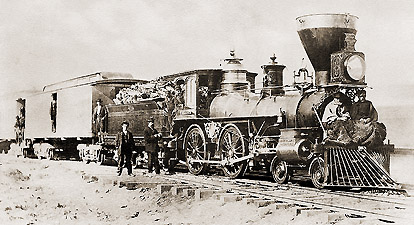 The mountain work was soon completed, and the CP was pushing eastward across the Nevada plane. Service opened to Reno, Nevada, 155 miles from Sacramento, on June 19, 1868.
The mountain work was soon completed, and the CP was pushing eastward across the Nevada plane. Service opened to Reno, Nevada, 155 miles from Sacramento, on June 19, 1868.
Track construction continued eastward following the Truckee River to Wadsworth, then the California Trail and Humbolt River eastward toward Utah. Service to Winnemucca began on October 1, 1868, and Argenta on November 19, 1868. Tracks were completed 10 miles east of Elko, Nevada, 478 miles from Sacramento, at the beginning of 1869.
To reduce conflict with the local Native American groups James Strobridge, the construction superintendent of the Central Pacific, offered the Paiute and Shoshone Indians free rides on the trains. The Central Pacific also employed some Native Americans building the railroad.
Union Pacific Begins Laying Track in Omaha
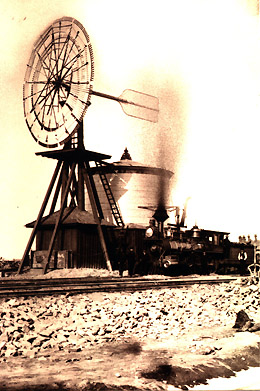 The Union Pacific Railroad was incorporated on July 1, 1862 in the wake of the Pacific Railroad Act of 1862. Its dominant stockholder and partner was Thomas C. Durant who was also selected as Vice President.
The Union Pacific Railroad was incorporated on July 1, 1862 in the wake of the Pacific Railroad Act of 1862. Its dominant stockholder and partner was Thomas C. Durant who was also selected as Vice President.
The determination for the starting point of the Union Pacific was left up to President Lincoln who selected Council Bluffs, Iowa, on the East bank of the Missouri River, based on the advise of his former client Thomas Durant. Council Bluffs was a major outfitting point on the Missouri for the Oregon Trail with a lively steamboat trade. Omaha, Nebraska was directly across the river. Council Bluffs and Omaha were well north of the Civil War fighting taking place in Missouri, was the shortest route to the South Pass break in the Rockies in Wyoming, and would follow a fertile river that would encourage settlement.
Durant created a separate company, Crédit Mobilier of America, to carry out the construction of the railroad, to limit the liability of stockholders and to maximize profits from construction. The company was the sole bidder for construction contracts from Union Pacific, with the substantial fees being paid by federal subsidies. The company also provided discounted shares of stock to members of Congress who agreed to support additional funding.
The Union Pacific didn't start laying rail in Omaha until July 1865. By January 1866, the Central Pacific had laid 60 miles of track, and the Union Pacific had only laid 40 miles of track to Fremont, Nebraska. The tracks roughly paralleled the Oregon Trail and the Platte River to North Platte. Union Pacific crews reached an important milestone when they passed the 100th meridian near what is now Cozad, Nebraska, 247 miles from Omaha, on October 6, 1866. North Platte, Nebraska, 292 miles from Omaha, was reached in December 1866. From North Platte the tracks followed the South Platte River to Julesburg, Colorado Territory, which was reached in June 1867.
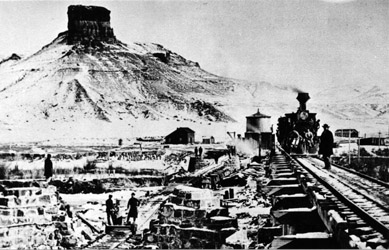 The Union Pacific crews were led by Grenville Dodge, the Chief Engineer, and Jack Casement who supervised the Union Pacific construction. Construction crews were made up of primarily Irish immigrants and Civil War veterans. Others included Native Americans, German and English immigrants, and a few local workers including Mormons in Utah. In addition to the track layers, construction also required hundreds of blacksmiths, carpenters, engineers, masons, surveyors, teamsters, telegraphers, and even cooks.
The Union Pacific crews were led by Grenville Dodge, the Chief Engineer, and Jack Casement who supervised the Union Pacific construction. Construction crews were made up of primarily Irish immigrants and Civil War veterans. Others included Native Americans, German and English immigrants, and a few local workers including Mormons in Utah. In addition to the track layers, construction also required hundreds of blacksmiths, carpenters, engineers, masons, surveyors, teamsters, telegraphers, and even cooks.
The Union Pacific progress was often resisted by Native American Indian groups who opposed the incursion of the work gangs and railroad into their hunting areas. They saw the construction of the railroad as a violation of their treaties with the United States. War parties began to raid the moving labor camps that followed the progress of the line. Union Pacific responded by increasing security and by hiring marksmen to kill American Bison - which were both a physical threat to trains and the primary food source for many of the Plains Indians.
The Union Pacific reached Cheyenne, Wyoming November 13, 1867. The highest point on the Union Pacific line, Lone Tree Pass, at 8200 feet, was reached on April 16, 1868 (later renamed Sherman Summit in honor of General William Tecumseh Sherman). The Union Pacific completed 450 miles of track to the Utah - Wyoming border by the end of 1868.
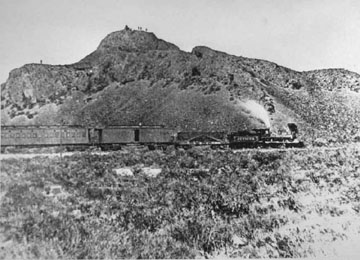 Central Pacific and Union Pacific Tracks Meet at Promontory, Utah
Central Pacific and Union Pacific Tracks Meet at Promontory, Utah
The two companies couldn't agree on a meeting place and began grading parallel lines, with the Central Pacific arguing for Ogden, Utah as the meeting place and the Union Pacific arguing for a point further west. On April 10, 1869 Congress designated Promontory, Utah as the meeting point for the two companies, the Central Pacific would purchase the trackage to Ogden, 54 miles east of Promontory.
As the two lines approached, Crocker added a few Irish workers to his crews. He won a $10,000 bet with Union Pacific directors when his crews laid 10 miles of track in one day on April 28, the longest stretch of track that has been built in one day to date.
Dignitaries and others gathered at Promontory, Utah on May 10, 1869. The Central Pacific's Locomotive No. 60, Jupiter and crew had arrive with it's train from the west, 690 miles from Sacramento, facing it only a few yards away was the Union Pacific's Locomotive No. 119 and crew which had arrived with a train from the east. Durant, of the Union Pacific, was responsible for driving a silver spike and Stanford, president of the Central Pacific, was responsible for driving the final golden spike. A telegraph operator had set up wiring so the driving of the final spike could be broadcast throughout the nation.
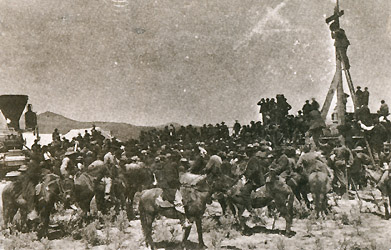 The country waited silently for a nationwide telegraph signal marking the completion of the transcontinental rail line. A group of people gathered around the Western Union office in Sacramento, as others did throughout the country. All other communication was halted about 11:20 a.m. At 11:41 the message was received that the spike was about to be presented. At 11:44 the signal "all
is ready now" was received. At 11:46, with the final blow to the final spike, the message was sent out all across America: "done." A golden spike was ceremoniously driven at Promontory by Governor Leland Stanford and Thomas Durant, marking the completion of the line. Although both men missed hitting the spikes into the pre-drilled holes, the telegrapher at Promontory, W. N. Shilling, imitated the final hits with his key.
The country waited silently for a nationwide telegraph signal marking the completion of the transcontinental rail line. A group of people gathered around the Western Union office in Sacramento, as others did throughout the country. All other communication was halted about 11:20 a.m. At 11:41 the message was received that the spike was about to be presented. At 11:44 the signal "all
is ready now" was received. At 11:46, with the final blow to the final spike, the message was sent out all across America: "done." A golden spike was ceremoniously driven at Promontory by Governor Leland Stanford and Thomas Durant, marking the completion of the line. Although both men missed hitting the spikes into the pre-drilled holes, the telegrapher at Promontory, W. N. Shilling, imitated the final hits with his key.
The United States was now united by the 1780 mile long Pacific Railroad, and celebrations occurred in every major American City. Church bells rang out, factory whistles were blown, fire-bells were rung and cannons were fired throughout the country. A one hundred gun salute was fired in New York City. The Liberty Bell rang out in Philadelphia's Independence Hall. San Franciscans turned out for military and civilian parades and danced in the streets, while Sacramento residents celebrated for three days. The dream of a generation had become a reality.
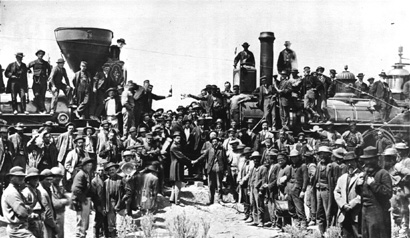 The Central Pacific completed the final leg of the route, connecting Sacramento to San Francisco, on November 8, 1869, via subsidiaries Western Pacific Railroad and San Francisco Bay Railroad.
The Central Pacific completed the final leg of the route, connecting Sacramento to San Francisco, on November 8, 1869, via subsidiaries Western Pacific Railroad and San Francisco Bay Railroad.
Initially the Union Pacific at Omaha was not directly connected to the Eastern U.S. rail network. Instead, trains had to be ferried across the Missouri River from the Chicago and North Western Railway in Council Bluffs, Iowa.
In August 1870 the Kansas Pacific laid the last spike connecting to the Denver Pacific line at Strasburg, Colorado. The combined line connected Kansas City to Denver, and to the Union Pacific line at Cheyenne, and actually provided the last link in the coast-to-coast all railway network. The Pacific Railway Act authorized large land grants to each railroads along its mainline. Such grants were to be distributed to homesteaders who would populate the lands near the railroad, forming new towns and providing the economic activity needed to support the railroad itself.
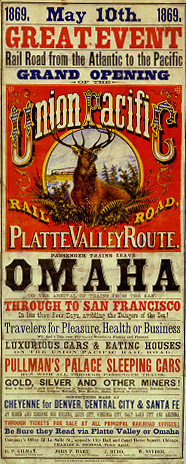 In 1872, the Union Pacific Missouri River Bridge opened connecting the Union Pacific with the Chicago and North Western Railway in Council Bluffs, Iowa, directly connecting the East and West by rail.
In 1872, the Union Pacific Missouri River Bridge opened connecting the Union Pacific with the Chicago and North Western Railway in Council Bluffs, Iowa, directly connecting the East and West by rail.
Reduced transportation time and cost bring new towns and immigrants
With the opening of the line, the travel time from the East to San Francisco was reduced from weeks or months to about one week. Advertisements described this new line as the safest for travelers, most attractive for tourist and most direct for for immigrants across the American Continent. Immigrants, machinery, mail and manufactured goods rolled westward. Western natural resources and food soon rolled eastward feeding the eastern half of the Nation.
Towns were founded and grew out of end-of-track towns along the transcontinental railroad route, among them North Platte, Lexington, Juelsburg, Cheyenne, Larime, Rock Springs, and Evanston. Purchasing land that the railroads had received as land grants, people settled in the new towns laying out streets, building homes, businesses, ranches and farms.
The two railroads launched campaigns to attract settlers, printing colorful posters, maps showing the areas for sale and educational booklets to encourage people to settle the West. Agents were sent throughout the eastern states and Europe to promote settlement along the line. Trainloads of immigrants arrived at the various towns, sometimes alone, sometimes as part of a group, all looking to fulfill the American Dream, to build new lives, new farms and new communities along the railroad line. Together they transformed the western United States.
For most of the new settlers on the prairie or in the mountains the trains that moved along the line were the only link with the rest of civilization, bringing needed news, mail, goods and hardware. The same trains provided a way for farmers to sell the food they produced to distant consumers. The railroad depot became the center of community life.
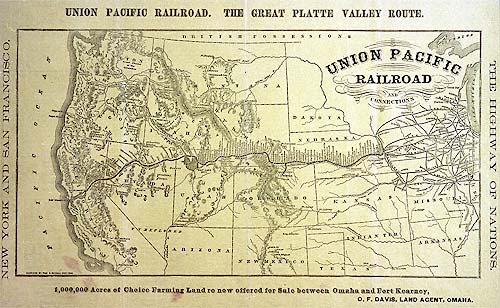 Much has been written about the questionable fund raising schemes and financial manipulations of both companies, both to attract investors and to insure a healthy profit for themselves. In the end, the UP laid a total of 1038 miles and the CP laid 742 miles of track. The bottom line is that the railroad was successfully completed and began regular operation in record time. The railroad has since been considered the greatest American technological feat of the 19th century.
Much has been written about the questionable fund raising schemes and financial manipulations of both companies, both to attract investors and to insure a healthy profit for themselves. In the end, the UP laid a total of 1038 miles and the CP laid 742 miles of track. The bottom line is that the railroad was successfully completed and began regular operation in record time. The railroad has since been considered the greatest American technological feat of the 19th century.
Over the next decades several short line railroads were also build connecting additional communities, mining and agricultural areas with the transcontinental line and the rest of the nation.
Next: competition to create a second transcontinental line through Southern California brought competition for business to the Golden State.
For additional reading:
- Bain, David Howard. Empire Express; Building the First Transcontinental Railroad. New York, Penguin Putnam, 1999.
- Best, Gerald. Iron Horses to Promontory. San Marino, California: Golden West Books, 1969.
- Combs, Barry B. Westward to Promontory: Building the Union Pacific across the plains and mountains. New York: Promontory Press, 1969.
- Kraus, George. High Road to Promontory: Building the Central Pacific across the High Sierra. Palo Alto, California: American West Publishing Company, 1969.
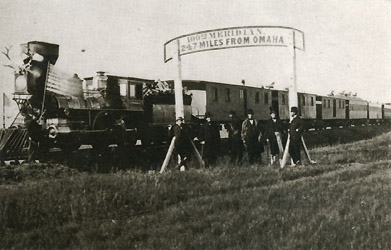
Online Resource Links:
- American Experience: The Transcontinental Railroad. WBGH for PBS, 1999 and 2003
- Burns, Ken. The West: The Grandest Enterprise Under God. WETA for PBS, 2001
- Goodwin, Niel. American Experience: The Iron Road. Peace River Films for PBS
- National Park Service. Golden Spike National Historic Site, also Education and Research
"The Pacific Railroad will, as soon as commerce shall begin fully to realize its advantages, demonstrate the necessity of such improvements in railroading as to render practicable the transportation of freights at much less rates than are possible under any system which has been thus far anywhere adopted."
Governor Leland Stanford, Promontory, Utah, May 10, 1869.
Sharing A Heritage Railroad History Train Technology Railroad Operation Railroad Time Museums & Heritage Railroads Railroads Today
